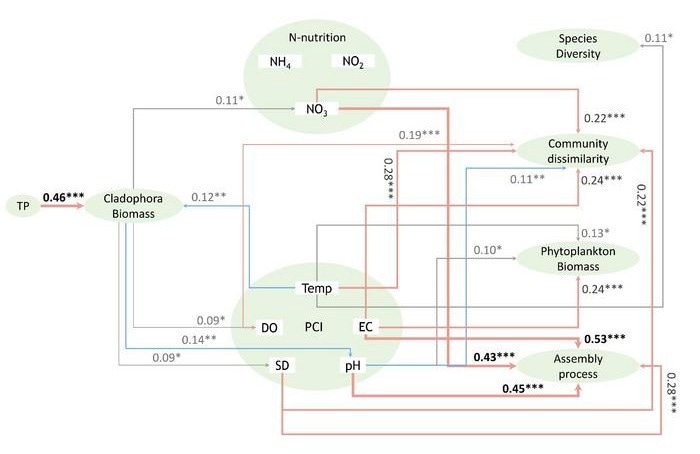The rampant proliferation of filamentous algae has emerged as a worldwide issue, presenting significant obstacles to the effective control of prominent water reservoirs, such as Qinghai Lake in China, the largest lake on the Qinghai-Tibet plateau.
 Correlation among Cladophora biomass, phosphorus, nitrogen, physicochemical properties, phytoplankton species diversity, community dissimilarity, phytoplankton biomass, and assembly processes. Species diversity, community dissimilarity, phytoplankton biomass, and assembly processes were measured using the Shannon diversity index, Bray-Curtis distances, concentration of Chlorophyll a, and βNTi respectively. The width of arrows indicates the Spearman's correlation coefficient, while the color of arrows represents significant correlations. ∗, p < 0.05; ∗∗, p < 0.01; ∗∗∗, p < 0.001. Abbreviations: Temp, temperature; DO, dissolved oxygen; SD, secchi depth; EC, electrical conductivity; TP, total phosphorus; NH4+, ammonia; NO3− ,nitrate; NO2−, nitrite. Image Credit: Zhihua Wu.
Correlation among Cladophora biomass, phosphorus, nitrogen, physicochemical properties, phytoplankton species diversity, community dissimilarity, phytoplankton biomass, and assembly processes. Species diversity, community dissimilarity, phytoplankton biomass, and assembly processes were measured using the Shannon diversity index, Bray-Curtis distances, concentration of Chlorophyll a, and βNTi respectively. The width of arrows indicates the Spearman's correlation coefficient, while the color of arrows represents significant correlations. ∗, p < 0.05; ∗∗, p < 0.01; ∗∗∗, p < 0.001. Abbreviations: Temp, temperature; DO, dissolved oxygen; SD, secchi depth; EC, electrical conductivity; TP, total phosphorus; NH4+, ammonia; NO3− ,nitrate; NO2−, nitrite. Image Credit: Zhihua Wu.
While many studies have focused on micro-algal blooms, there remains limited research on filamentous algal blooms (FABs).
Cladophora, a filamentous green algae with widespread distribution in marine and freshwater environments, has been identified as a catalyst for substantial and diverse populations of microalgal and bacterial epiphytes.
These organisms play a pivotal role in carbon cycling and regulating other essential elements. Consequently, Cladophora is often described as an “ecological engineer.”
While highland lakes like Qinghai Lake are typically classified as oligotrophic, characterized by low phytoplankton levels and a stable structure of zooplankton and benthic communities, the recent rise in water levels due to a warmer and more humid climate has created favorable conditions for Cladophora growth in the newly inundated littoral zone.
Additionally, the abundance of bird droppings near Bird Island serves as a phosphorus source, further stimulating Cladophora growth.
This resurgence of Cladophora blooms marks a return after an interruption lasting nearly half a century. Nevertheless, the impact of Cladophora meadows on phytoplankton, especially in the context of alpine lakes, remains unclear.
To address this gap, a team of researchers in China conducted a comprehensive analysis of phytoplankton communities in different regions of Qinghai Lake across various seasons using meta-barcode sequencing.
We compared the phytoplankton assemblages in areas with Cladophora blooms to those without. We found a correlation between the phytoplankton community structure and various physicochemical factors, including water temperature, electrical conductivity, nitrate levels, and the presence or absence of Cladophora bloom.”
Zhihua Wu, Study Lead Author, Institute of Hydrobiology, Chinese Academy of Sciences
The research revealed a higher relative abundance of Bacillariophytes in regions experiencing Cladophora blooms compared to other areas.
Furthermore, these zones with Cladophora blooms exhibited seasonal variations in phytoplankton biomass and β diversity.
The team, whose findings were published in the KeAi journal Water Biology and Security, proposed a hypothesis that suggests Functional Assemblages of Bacteria (FABs) in alpine lake ecosystems could play a role in shaping phytoplankton communities.
FABs can alter the assemblage and assembly process by providing more microhabitats for algae. They could also lead to shifts in the nitrogen level particularly nitrate, possibly through interactions with other nitrogen-fixing organisms.”
Zhihua Wu, Study Lead Author, Institute of Hydrobiology, Chinese Academy of Sciences
Wu added, “The presence of FABs and its degradation may lead to changes in physicochemical properties, particularly pH, dissolved oxygen, and suspended solids which, in turn, can affect the structure of the phytoplankton community.”
Source:
Journal reference:
Wu, Z., et al. (2023) Cladophora as ecological engineer: A new test from the largest lake of Qinghai-Tibet plateau with filamentous algal blooms. Water Biology and Security. doi.org/10.1016/j.watbs.2023.100210.